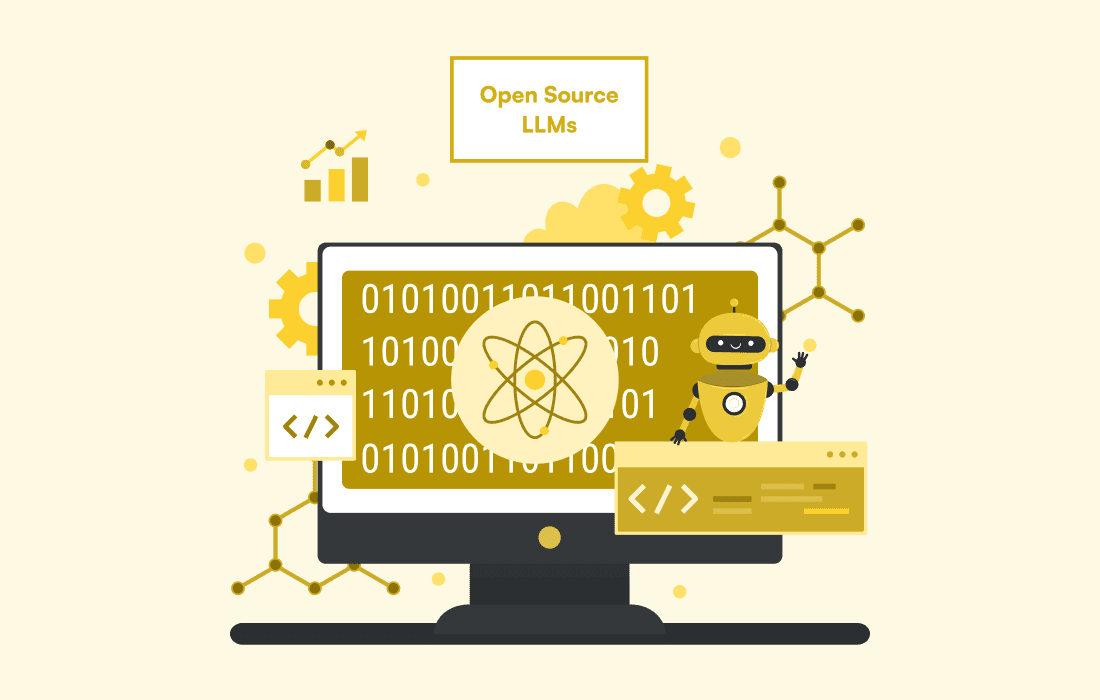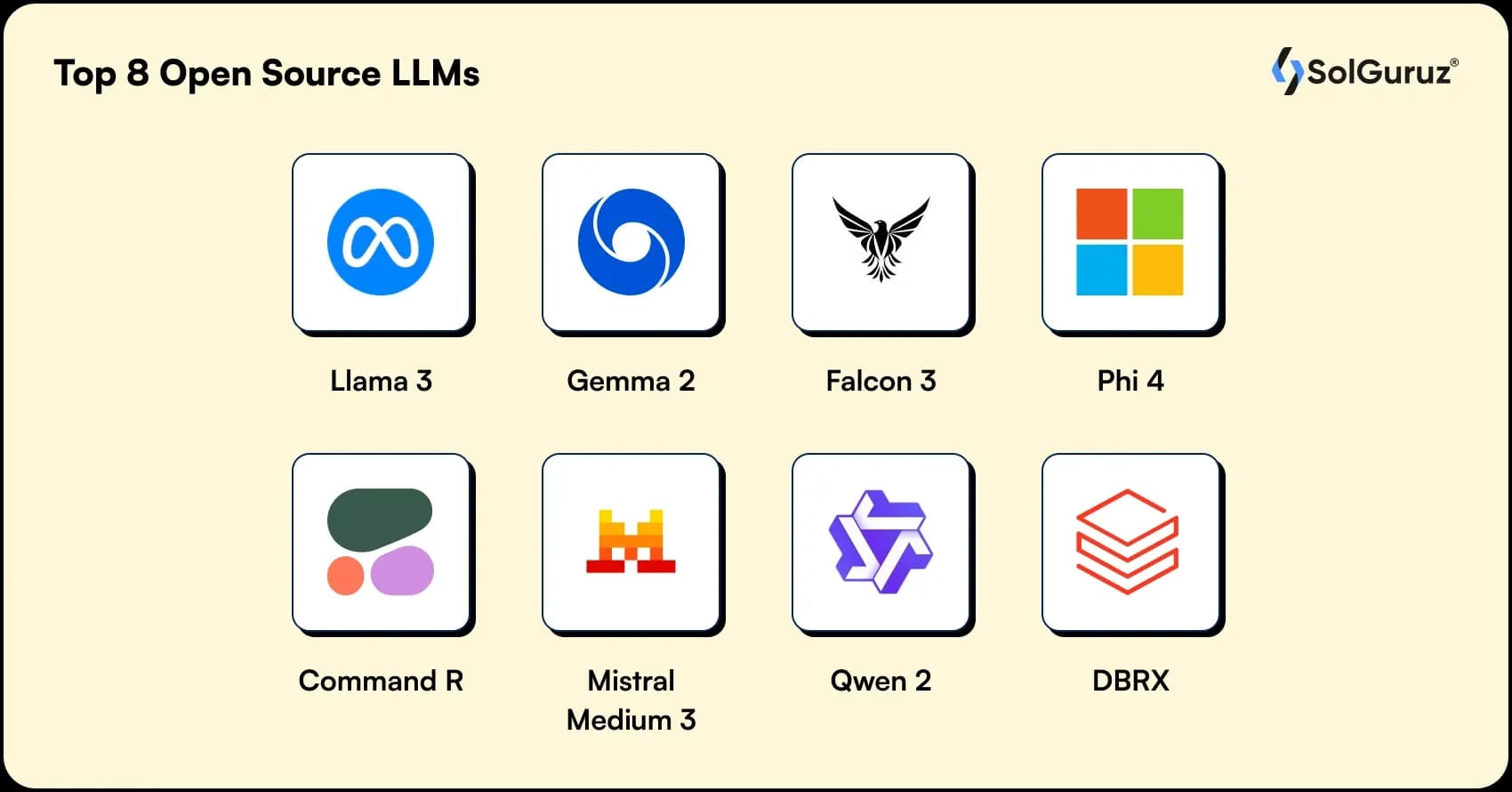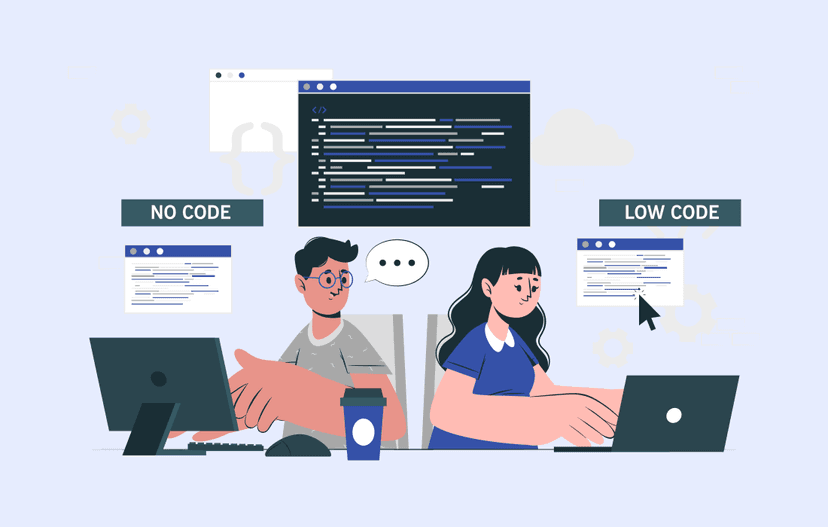Top 8 Open Source LLMs for 2025: Compare, Choose, and Deploy the Best Models
Choosing the right open-source LLM can transform your AI projects, saving costs and enhancing performance. From deployment to fine-tuning, understanding the model that fits your business goals is crucial. With expert support and ongoing insights, SolGuruz is here to guide you through every step, from selection to implementation.

Open source LLMs help you create powerful AI solutions that enable you to get more done in less time (and at a lower cost!)
But there are more than 100 LLM models in the market.
Therefore, choosing the “best one” becomes a challenge!
That’s where this guide comes in.
We have mentioned the top 8 open-source LLMs for 2025, along with their
- Pros and cons
- Real-world use cases

By the end of the blog, you will be able to choose the best-fit LLM model for your business.
Let’s get into it!
Table of Contents
Head-to-Head Comparison of Top 8 Open Source LLMs for 2025
On a whim?
Don’t worry! Here is a detailed comparison.
We have written LLM models that are customizable and powerful.
PS: Some are even ideal for self-hosting if that’s part of your strategy.
If you’re interested in running your chosen LLM locally, check out our guide on how to train and host a self‑hosted LLM here.
| Model Name | Use Cases | Hardware Requirements | Performance Metrics |
| Llama 3 | Research, startups | GPUs or TPUs, scalable | High accuracy, low latency |
| Gemma 2 | R and D, multilingual tasks | Low to medium compute | Fast and highly accurate |
| Falcon 3 | Enterprise, academic | High compute needed | Scalable, fast inference |
| Phi 4 | High accuracy tasks | High computing required | Extremely accurate |
| Command R+ | Commercial applications | Medium compute needed | Fast and flexible performance |
| Mistral Medium 3 | R and D, AI projects | Medium compute needed | Balanced performance |
| Qwen 2 | Large-scale deployments | GPUs or TPUs | High throughput, low latency |
| DBRX | Data science, academic | Flexible hardware | Robust performance |
1) Llama 3 (Meta)
Best For: Teams that want strong performance without relying on closed paid APIs. Works well for research, startups, internal tools, and early product development.
Businesses choose Llama 3 because it offers high-quality output while still giving full control over how and where the model runs. You are not locked into a specific vendor or pricing plan.
You can self-host it, fine-tune it to your own data, and maintain data privacy since nothing needs to leave your environment.
The model also has a large adoption base, which makes it easier to find support, tutorials, and ready-to-use improvements. In short, Llama 3 provides strong results while giving you flexibility and ownership.
Pros
- Strong performance across writing, reasoning, and knowledge tasks
- Easy to customize and fine-tune for business workflow needs
- Large community and plenty of existing guides and model variations
- Allows data privacy and internal deployment
Cons
- Larger versions may require powerful GPUs to run smoothly
- May still need fine-tuning to match specific industry or domain knowledge
2) Gemma 2 (Google/DeepMind)
Best For: Teams that need strong multilingual support or want to build AI products that work across different regions and languages.
Gemma 2 is a good choice if your business needs reliable language understanding beyond English. It is trained on diverse global data, which helps it produce clear and natural responses in multiple languages.
This makes it helpful for support teams, global products, translation workflows, and research involving different language groups. Gemma 2 is also designed to run more efficiently, so you do not always need heavy hardware to deploy it. If your goal is to reach a wider audience or operate across multiple countries, Gemma 2 is a practical fit.
Pros
- Strong multilingual performance
- Clear and natural text generation
- Can run on lower to medium compute setups
- Useful for international or multi-region products
Cons
- May need tuning to match specific industry language or tone
- Larger versions may consume more compute as usage scales
3) Falcon 3 (TII)
Best For: Large teams or organizations that need strong performance for high-volume workloads. Works well for enterprise systems, research labs, and academic environments.
The next open source model many teams trust is Falcon 3. It has earned a strong reputation for being reliable when your workloads grow. If your product or internal tools need to serve many users at once, Falcon handles that scale without slowing down.
It is designed for stability, consistent output quality, and long-running usage. This makes Falcon a good choice for businesses that want to move beyond experiments and start running AI in production environments.
Pros
- Handles large user traffic and heavy workloads smoothly
- Reliable performance in long-running deployment
- Suitable for enterprise and production environments
- Well tested in research and academic settings
Cons
- Needs powerful computing resources to run properly
- May feel heavy for smaller teams or lightweight use cases
4) Phi 4 (Microsoft)
Best For: Teams that want strong accuracy for reasoning, writing, and structured tasks. Suitable for research, product teams, and workflows where the quality of output matters more than speed.
Phi 4 is known for producing accurate and thoughtful responses. It is a good choice when you need the model to interpret context well and provide clear output, especially in business or academic tasks.
It focuses on instruction quality and reliable output, which makes it useful for tasks like document processing, analysis, and structured content creation. If your goal is to build tools that need strong reasoning or decision assistance, Phi 4 is a strong option.
Pros
- High accuracy in reasoning and structured content
- Good for detailed responses and analytical tasks
- Works well for research and professional use cases
- Produces clearer and more focused output
Cons
- Requires strong computing to run smoothly
- May feel slower in fast chat or high-volume usage situations
5) Command R or Command R+ (Cohere)
Best For: Teams building customer-facing applications or workflows that need fast responses. Works well for chatbots, support tools, and product automation.
Command R and Command R Plus are designed to be practical and efficient. They focus on quick responses and easy integration into business systems.
If your team wants to build an AI feature inside a product without spending weeks on configuration, Command R is a helpful option. It offers clear output and works well with real-time tasks where speed and reliability are important.
Pros
- Fast and responsive output
- Easy to integrate into products and workflows
- Good fit for customer support and automation tools
- Practical choice for daily business usage
Cons
- May not match the top models in deep reasoning tasks
- Quality may vary depending on domain complexity
6) Mistral Medium 3
Best For: Teams that want a balanced model that performs well without needing high compute. Works well for prototypes, internal tools, and proof of concept projects.
Mistral Medium 3 offers a balanced approach to performance and resource usage. It is helpful when you want good output quality while keeping the computational needs manageable. This makes it suitable for smaller teams or early product phases where efficiency matters. If your goal is to experiment, build, and test ideas quickly, Mistral Medium 3 fits that workflow.
Pros
- Balanced performance for everyday tasks
- Works on commonly available GPU setups
- Easy to experiment with and iterate on
- Helpful for early development stages
Cons
- May require tuning for complex industry tasks
- Not the fastest choice for heavy volume workloads
7) Qwen 2 (Alibaba)
Best For: Teams working on large-scale applications or systems that need high throughput and stable response quality.
Qwen 2 is built for scale. It handles heavy loads and large batches of requests without slowing down. This makes it useful for enterprise environments, cloud platforms, and multi-user systems. If your team anticipates high traffic or plans to deploy AI across many users or locations, Qwen 2 helps maintain reliability and consistency.
Pros
- Handles large-scale usage smoothly
- Good for multi-user and distributed systems
- Strong performance in production environments
- Stable and consistent output quality
Cons
- May require a strong computer setup to run efficiently
- It could be more complex to manage for smaller teams
8) DBRX (Databricks and Mosaic ML)
Best For: Data science teams and organizations that want to train and customize models on their own datasets.
DBRX is designed for cases where data ownership and customization matter. It allows you to train and adjust the model to your own business data. This is helpful for specialized fields, internal knowledge bases, or workflows where industry-specific accuracy is important. If your organization values control over training and model behavior, DBRX is a strong fit.
Pros
- Good for fine-tuning and custom training
- Strong fit for data science and research teams
- Works well with custom or private datasets
- Flexible deployment options
Cons
- Requires technical knowledge to get the best results
- Training and tuning may require significant computing resources
Ready to Build with the Right Open Source LLM?
This was the list of the top open source LLMs in 2025.
All the models we mentioned are the best in the market.
But they also weigh their own strengths and weaknesses.
Therefore, make sure you analyze your requirements and then make a smart decision.
If you are planning to build or scale an AI solution and need the right talent to make it happen, our team at SolGuruz can help.
We have experienced AI and ML developers who can help you design, fine-tune, and deploy your LLM-based products in a secure and efficient way.
FAQs
1. Why do you need LLM models in your business?
Large Language Models are the key to automating a wide variety of content-related tasks such as content generation, summarization, and even customer support.
In addition, they can be employed for user interactions, thereby increasing productivity and allowing AI-driven features to scale in products.
With open-source LLMs, you can not only avoid the expensive API costs but also have more freedom in the customization of your functions.
2. How do I pick the most suitable open-source LLM for my project?
- Define your use case: Know what task you want the model to do (e.g., writing, research, or customer service).
- Performance versus cost: Get a model that can offer you optimum results within your hardware and monetary constraints.
- Think of scalability: The model you choose should be able to expand with your business later on.
3. What are the hardware requirements for LLM models?
As a rule, LLMs require top-of-the-line graphics cards or tensor processing units if they are to be operated smoothly, and this is more so for big models.
At the same time, smaller models may be run on computer hardware of a lower grade, however, with some sacrifice of performance.
Make sure that your current software and hardware setup is compatible with the model you want to use.
4. Can I conduct fine-tuning of an LLM with my data?
Yes, almost all open-source models allow you to conduct fine-tuning of the model on your data to fine-tune the model for improved accuracy and relevance.
Fine-tuning allows you to reprioritize the model for a specific business requirement, which provides industry-specific jargon or a unique step-by-step process for your organization.
5. What are the use cases of LLMs in business?
- Customer support automation: Automate AI chatbots or support agents to handle customer inquiries
- Content generation: Automating writing and/or production tasks for blog posts, summaries, product descriptions, etc
- Data analysis: Automating the ability to extract information from large volumes of text-based data
- Task automation: Automate the fluency when using an LLM as part of a workflow
Written by
Paresh Mayani
Paresh Mayani is the Co-Founder and CEO of SolGuruz, a globally trusted IT services company known for building high-performance digital products. With 15+ years of experience in software development, he has worked at the intersection of technology, business, and innovation — helping startups and enterprises bring their digital product ideas to life. A first-generation engineer and entrepreneur, Paresh’s story is rooted in perseverance, passion for technology, and a deep desire to create value. He’s especially passionate about mentoring startup founders and guiding early-stage entrepreneurs through product design, development strategy, and MVP execution. Under his leadership, SolGuruz has grown into a 80+ member team, delivering cutting-edge solutions across mobile, web, AI/ML, and backend platforms.
Get the Right Open-Source LLM for Your Business
Find the best model for your needs and start implementing it with expert guidance and support.

1 Week Risk-Free Trial

Strict NDA

Flexible Engagement Models
Give us a call now!

+1 (724) 577-7737


